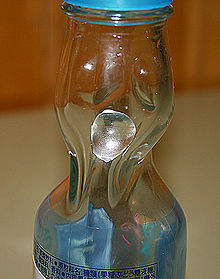Ramune
 | |
| Type | Soft drink |
|---|---|
| Manufacturer | Various |
| Distributor | Nishimoto Trading Co., Ltd., Sangaria U.S.A., Inc. |
| Country of origin | Japan |
| Introduced | 1884 |
| Color | Clear |
| Flavour |
|
Ramune (ラムネ) (Japanese pronunciation: [ɾamɯne]) is a Japanese carbonated soft drink. It was introduced in 1884 in Kobe by the British pharmacist Alexander Cameron Sim.[1] Like Banta, an Indian lemon drink, Ramune is available in a Codd-neck bottle, a heavy glass bottle whose mouth is sealed by a round marble (instead of a cap) thanks to the pressure of the carbonated contents.[2][3] The name Ramune is derived from a Japanese borrowing of the English word lemonade.[4][5]
The drink was also popular during the 1960s in Iraq and Gulf Arab countries.[citation needed]
History[]
In 1884, Sim introduced this carbonated beverage based on lemonade to the Kobe foreign settlement. This drink, called "mabu soda" for "marble soda" due to the marbles placed in the bottle for opening action, soon became very popular with the local Japanese after it was advertised in the Tokyo Mainichi Newspaper as a preventative for cholera. The drink remains a popular soft drink, sold worldwide, under the name of ramune to this day.
Bottle design[]

Ramune is known for the distinctive design of its bottle, called Codd-neck bottles after their inventor, Hiram Codd. They are made of glass and sealed with a marble; the codd head is held in place by the pressure of the carbonation in the drink. To open the bottle, a plastic device used to push the marble inward is provided.
The marble is pushed inside the neck of the bottle where it rattles around while drinking. Therefore, the drinks are sometimes called "marble soda" outside Japan.[6] While the Codd-neck bottle was once commonly used for carbonated drinks, today Ramune, along with Banta, is one of its very few users.
People trying Ramune for the first time sometimes find it difficult to drink, as it takes practice to learn to stop the marble from blocking the flow. In one version of the bottle introduced in 2006, little slots were added to the cap where the marble was originally held. This prevented the flow from obstruction if the marble falls back into the cap. Ramune is also available in plastic PET bottles and cans.
Ramune is one of the modern symbols of summer in Japan and is widely consumed during warm festival days and nights. Empty bottles are usually collected for recycling at stalls where it is sold.
Flavours[]
The original ramune flavour is lychee. Including original, there have been 57 flavours of ramune: banana, bloody grapefruit, blueberry, blue Hawaii, bubble, bubble gum, candy, champagne, cherry, chili oil, chocolate, coconut, cola, cotton candy, corn potage, cream stew, curry, disco dance, dragon fruit, flaming, ginseng, grape, green apple, green tea, kimchi, kiwi, lemonade, lychee, mango, mango & pine, melon, muscat, mystery, octopus, orange, peach, pineapple, plum, pomelo, pomegranate, raspberry, red champagne, root beer, sour, sour watermelon, strawberry, sweet, takoyaki sauce, teriyaki, tropical banana, vanilla, wasabi, watermelon, yogurt, and yuzu.[7]
See also[]
- Banta
- Calpis
- List of soft drinks by country
- Oronamin C Drink
- Pocari Sweat
- Sangaria (soft drink)
References[]
- ^ "The History of Ramune, Japan's National Soda". Kotaku. Retrieved 2020-05-20.
- ^ Anuja & Krish Raghav (2 July 2010). "Pop culture". Mint. Retrieved 2014-08-17.
- ^ "Sipped for centuries". The Hindu. 10 June 2011. Retrieved 2014-08-17.
- ^ Greve, Gabi (2008-06-18). "Ramune (lemonade)". Washoku. Retrieved 2018-05-17.
- ^ "The Origin of Ramune". Japan Info. Retrieved 2018-05-17.
- ^ "Sangaria Ramune Marble Soda Japanese Bottle Drink 200ml". Amazon.
- ^ "へんてこな味がいっぱい!?日本一のラムネ会社に潜入" (in Japanese). July 2, 2018. Archived from the original on July 14, 2020. Retrieved March 25, 2021.
- Japanese drinks
- Lemon-lime sodas
- Soft drinks
- Scottish inventions
- 1884 introductions
